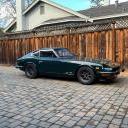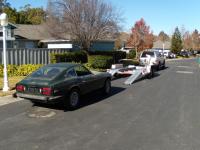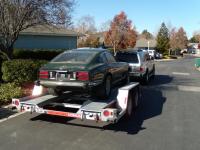Everything posted by LeonV
-
Springs....Eibach oor Tokiko or what?
Thanks for the feedback! Good to know about adjusting the front valence. I really like the fit of 225/50-16s but as you said, it'll require some altering to get those to work with the stock front valence. I have no issues on one Z which has a Xenon air dam but I want to run the stock valence with a lip on the other car. Looks like I may have to go down in size for my next set...
-
Gigantic warehouse sale full of 240z parts
I'm thinking the same thing...
-
Springs....Eibach oor Tokiko or what?
Does that combo work without trimming the stock front valence, i.e. there is no rubbing with the steering at full lock?
-
A converstion about how much compression is too much for pump gas
Steve makes good points. The cam I'm putting in the L28 I'm currently building is .540" lift and the pistons pop out of the bore .021". I'll be doing piston-head and piston-valve clearances soon and can report back. Pistons are flat-tops and compression should be close to 10:1.
-
ZFuel
Ha! The original flat-tops are sitting in storage, just in case.
-
A converstion about how much compression is too much for pump gas
It's not the overlap, but the intake valve closure point that's the important bit. No way to tell your compression ratio from that data. You need to know bore size, compressed head gasket thickness, and combusion chamber volume. The Holley can be part of the issue because of uneven mixture distribution. All it takes is one cylinder, one weak link, to cause knock. The wideband shows average AFR, not cylinder-to-cylinder differences. That engine is begging for triple carbs or standalone EFI. The more control you have, the better chance of alleviating your issues. In the meantime try colder plugs, cooler thermostat, and a slightly richer mixture, in that order. That makes a bit more sense. Sounds like your torque converter lockup changes depending on heat, since the torque converter is a fluid coupling. This has nothing to do with how much power your engine is making.
-
Rim research for my 1978 280Z
Your current setup is much more likely 14X6 wheels. Otherwise, I'm not sure how you fit 14" tires on 15" rims! I agree with the rest that those look like 15" Konig Rewinds. As for wheel pricing, I've sold 3 sets of 5-slot mags, with the 14X6 sets selling for $200 and the 14X7 for $250.
-
Potentiometer and timing question
Is siteunseen's name Leon, or am I missing something? That isn't the correct way to set timing. The correct way is on a dyno, anything else is just guessing. Seriously, an hour on the dyno will cost you maybe $100. I consider that a worthy investment. Maximum advance DOES NOT equal maximum torque. Read up on MBT (Max Brake Torque) timing.
-
A converstion about how much compression is too much for pump gas
Sure, tighter lash would leave it open a bit longer but it's not exactly what I was recommending. You can try but I'd go with the lash settings given by the cam grinder. I was recommending retarding the cam (as long as you have ample valve to piston clearance) to drop low-rpm cylinder pressure. You may need an adjustable cam sprocket for this depending on where your cam is currently set. If it's on the #2 hole, set it to #1. That will retard the cam by 4 degrees and may be enough to help. You'll lose a bit of low-end but make up for it in the high-end, if you notice anything at all. That makes absolutely no sense to me. Engine RPM to MPH is controlled by gear ratios, i.e. solid meshing gears that don't have magical temperature-sensitive gear ratios. Could you clarify what you mean here?
-
A converstion about how much compression is too much for pump gas
If colder plugs and cooler coolant doesn't help at all, I'd really consider going with a more aggressive cam or at the least retarding your cam. My hypothesis would be that the high heat and pressure caused by your current valve timing profile and static compression is causing engine knock. Knock is more likely to happen at lower RPM because it has more time to develop while waiting for the flame front to reach the hot spot. Therefore, you want to decrease cylinder pressure within the zone where knock happens. As far as valve timing goes, this is mainly done by delaying the intake valve closing point. That's a good plan for the future, IMO. An unshaven P79 or P90/P90A with flat-top pistons will get you to ~8.5-9:1. The shaved P90 that's going on my flat-top L28 has 44cc chambers and should give me approximately 10:1 compression. I was hoping for a bit lower but I'll probably be close to the edge of what I can run on pump gas, especially in CA where we get up to 91 at most pumps. I do have access to 100 octane if I need it, but I REALLY don't want to resort to that... You'll be fine, probably even on regular gas. That combo is ~8.5:1.
-
ZFuel
This escalated above my programming experience very quickly! Great work Lenny, this is a fantastic project.
-
ZFuel
Well keep up the awesome work! Fortunately, both the 260s have triple Webers.
-
A converstion about how much compression is too much for pump gas
Two very important things need to be mentioned here: 1. There is no specific compression ratio-to octane conversion, since knock-resistance is dependent upon much more than just static compression. Some key factors are combustion chamber design (including spark plug location), RPM, AFR, and valve timing profile. 2. Max timing DOES NOT equal max power. The optimal timing map for an engine is found during controlled dyno testing. There are a many reasons that can cause engine knock, as well as different types of knock. Fundamentally, knock is when a part of the mixture ignites before the flame front from the spark plug gets there. In your case, I'd be thinking about things getting too hot in the combustion chamber. This usually comes from three things: spark plug, exhaust valve, glowing deposits. Going to a cooler plug and/or dropping coolant temperatures could help, but not guaranteed. Spark plugs are easy enough to try out. However, if I were you, I'd pour in some 100 octane fuel and go to the dyno to see what YOUR engine really needs as far as timing goes. Come up with a "good" dyno testing strategy, i.e. minimize variables. Just keep in mind, knock happens for many reasons and is also dependent on ambient conditions. This is why there's a safety net built in on factory spark maps.
-
ZFuel
Very cool project! I haven't really been following as I don't have a 280Z but sounds like you've put forth a TON of effort and research. If I owned a 280Z or ZX with stock EFI, I'd be pretty damn excited! Are you designing and coding the tuning software/interface as well?
-
I spy a z!
Saw two yesterday. One was an orange 240Z in the Sunset, parked a block from 19th Ave in the morning. The other was a brown 280Z traveling on 19th Ave in the evening. Nice to see Zs out and about!
- Zcon Photos 2013
- Zcon Photos 2013
-
? on exhaust hangers
Rubber hangers are used for NVH reasons, as well as introducing some extra compliance to the exhaust system. Both are good things, especially the latter.
-
? on exhaust hangers
Seriously? Holy hell, that's a terrible idea! That's a lot of bending load placed on that joint, which is also transferred to your header primaries and exhaust manifold studs. I wouldn't be surprised to see pipes getting warped and/or cracks developing. At the very least, put a support at the muffler...
-
280Z Full Restore in 5 months, hopefully.
Great project, love the green/butterscotch!
-
EGR System - Theory Behing BPT Valve?
Since we're being pedantic, I'll make a few comments about performance effects of EGR... EGR does not "allow" increased spark advance, it DEMANDS it. EGR dilutes the fresh air/fuel mixture which slows the burn rate of the entire charge. Because of the slower burn rate, spark timing MUST be advanced in order to maintain performance. Thus, spark timing is increased to sustain performance, not increase it. On the pumping loss point, it's not the decrease in exhaust pressure that reduces pumping losses, or at least that's not the main driving factor. The increase in intake pressure (holding load constant) is what boosts performance, as the intake has a throttle valve to deal with. There's also another important factor in the performance bump and that's reduced heat loss to the cylinder and combustion chamber walls because of the lower flame temperature dictated by EGR. This means more of the fuel's energy is transferred to the piston and not lost as heat. Agreed. You're right. If you're talking about a diesel engine. A spark-ignited internal combustion engine has a throttle, which throttles the amount of air that enters the cylinder (where's Captain Obvious? )! Volumetric efficiency is the key word here, and it's drastically different from easy cruise and WOT. This is a very basic, yet important fundamental concept of SI (spark-ignition) engines. This is the whole reason for multiple-circuit carburetors!
-
Tow Dolly- How do you get non running car pushed up on the dolly?
You're thinking too hard. Two guys can push a Z up onto a dolly/trailer easily, especially one without an engine. It helps to have someone in the car in case steering adjustment is needed.
-
How does a triple weber choke behave?
A good target would be as lean as you can go while keeping the engine running smoothly. That might be 12-13:1 on a cold start. If you're at 14:1 at cold idle without start enrichment, then I bet you're too rich when the car is fully warm.
-
Noise!
Not sure what you mean by the suspension being "a bit bouncier" but removing the rear ARB should not be detrimental to around-town driving. It will only be noticeable when the car is driven harder, as an increase in steady-state understeer. The ARB does nothing if both wheels are in jounce/rebound.
-
Hello!
Welcome Theron! Cool to a member from Dorrington. We've been regularly staying there for YEARS during our winter ski trips. Love that place.






